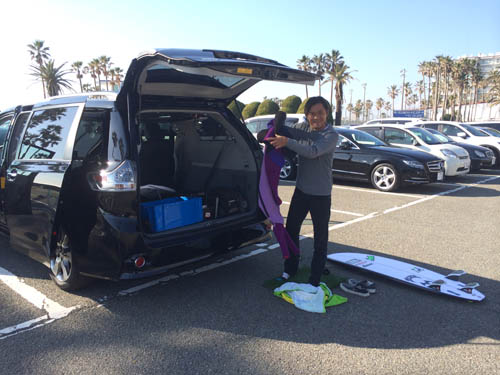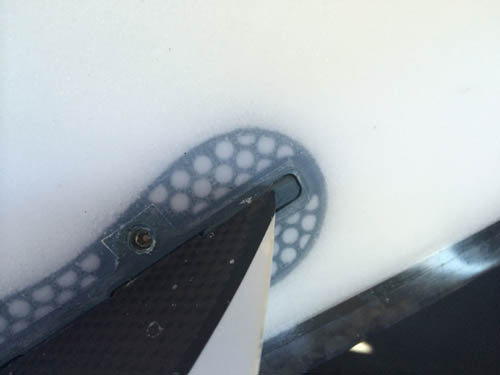
I arrived in Japan from San Clemente at the end of last year.
I rode Nishii's new personal board
, the "LAYZ POTATO," made of XTR-FX material, for the first time in 2014.
 The fins are WARd5 fins in a QUAD setting.
The fins are WARd5 fins in a QUAD setting.
 I tried riding it in the TRI setting, with the QUAD's smaller rear fin in the center.
I tried riding it in the TRI setting, with the QUAD's smaller rear fin in the center.

This
"LAYZ POTATO" XTR-FX board is of course equipped with the latest FCSII plugs,
When using AUROLA fins,
*To prevent the fins from slipping,
*To ensure smooth flow without letting the water flow into the box,
As you can see here, I used an infill kit.
Boards with FCSII plugs do not have FCS screws,
I also put in 10 screws myself later and rode it.
The board size is 5'5", the same as the ready-made size listed on the website:
| 5'5" x 19 5/8" x 2 1/4" |
(165 x 49.8 x 5.7 cm) |
Intermediate 47-52kg Advanced 52-57kg |
27.5cl |
The flex of the XTR-FX is really great.
Of all the XTR carbon materials available to date, this one has the flexibility that is closest to POLY, allowing you to step on the board.
When you step on it, the board sinks and bends, and then it bounces back up with great force as it tries to return to its original shape.
This high rebound performance, which bounces up like a strong spring, is unique to the XTR foam, called "SPEED FLEX."
It bounces back quickly, so when you step on the board, it accelerates quickly, similar to the feeling of suddenly stepping on the accelerator in a car.
How was it possible to recreate the flex of POLY?
Arctic blanks (foam) used in Lost's POLY boards usually consist of three wooden stringers glued together, but the XTR blanks in the XTR-FX boards are made of just one, which is extremely effective, as the wooden stringer is only one-third the thickness.

The new square carbon material, which is attached to both rails using a vacuum method, is larger in size, so it has better flexibility than small, square carbon material, and is much softer than the previous 3D CARBOLIC Kevlar carbon material, so the board flexes.
There are currently six ready-to-ride board models made from the "XTR-FX" material.
"LAYZ POTATO"
http://www.luvsurf.co.jp/models/lost/layz-potato
"COUTH POTATO"
http://www.luvsurf.co.jp/models/lost/couch-potato
"SUB-DRIVER-JP"
http://www.luvsurf.co.jp/models/lost/sub-driver-jp
SUB-SCORCHER II
http://www.luvsurf.co.jp/models/lost/sub-scorcher2
"BEACH BUGGY"
http://www.luvsurf.co.jp/models/lost/beach-buggy
"STEALTH II"
http://www.luvsurf.co.jp/models/lost/stealth-ii
The flex of the XTR-FX, which overturns the image that XTR boards are stiff, can only be experienced by those who ride it.
Those who have ridden XTR boards up until now will definitely be the ones who notice the difference the most, so I would definitely encourage you to give it a try.
Of course, it is also recommended for those who are switching from POLY to XTR boards for the first time, as
the high-rebound "SPEED FLEX" performance will allow you to seamlessly transition from a POLY board.
High-rebound "SPEED FLEX" performance and
Another reason to choose the XTR-FX board is that it is waterproof.
As you may already know, the blanks (foam) used in the XTR-FX do not absorb water.
You can ride the board lightly for as long as you like! (This is something that many people don't know, so please remember it.)
 I arrived in Japan from San Clemente at the end of last year.
I rode Nishii's new personal board , the "LAYZ POTATO," made of XTR-FX material, for the first time in 2014.
I arrived in Japan from San Clemente at the end of last year.
I rode Nishii's new personal board , the "LAYZ POTATO," made of XTR-FX material, for the first time in 2014.
 The fins are WARd5 fins in a QUAD setting.
The fins are WARd5 fins in a QUAD setting.
 I tried riding it in the TRI setting, with the QUAD's smaller rear fin in the center.
I tried riding it in the TRI setting, with the QUAD's smaller rear fin in the center.
 This "LAYZ POTATO" XTR-FX board is of course equipped with the latest FCSII plugs,
When using AUROLA fins,
*To prevent the fins from slipping,
*To ensure smooth flow without letting the water flow into the box,
As you can see here, I used an infill kit.
Boards with FCSII plugs do not have FCS screws,
I also put in 10 screws myself later and rode it.
The board size is 5'5", the same as the ready-made size listed on the website:
This "LAYZ POTATO" XTR-FX board is of course equipped with the latest FCSII plugs,
When using AUROLA fins,
*To prevent the fins from slipping,
*To ensure smooth flow without letting the water flow into the box,
As you can see here, I used an infill kit.
Boards with FCSII plugs do not have FCS screws,
I also put in 10 screws myself later and rode it.
The board size is 5'5", the same as the ready-made size listed on the website:
 The new square carbon material, which is attached to both rails using a vacuum method, is larger in size, so it has better flexibility than small, square carbon material, and is much softer than the previous 3D CARBOLIC Kevlar carbon material, so the board flexes.
There are currently six ready-to-ride board models made from the "XTR-FX" material.
"LAYZ POTATO"
http://www.luvsurf.co.jp/models/lost/layz-potato
"COUTH POTATO"
http://www.luvsurf.co.jp/models/lost/couch-potato
"SUB-DRIVER-JP"
http://www.luvsurf.co.jp/models/lost/sub-driver-jp
SUB-SCORCHER II
http://www.luvsurf.co.jp/models/lost/sub-scorcher2
"BEACH BUGGY"
http://www.luvsurf.co.jp/models/lost/beach-buggy
"STEALTH II"
http://www.luvsurf.co.jp/models/lost/stealth-ii
The flex of the XTR-FX, which overturns the image that XTR boards are stiff, can only be experienced by those who ride it.
Those who have ridden XTR boards up until now will definitely be the ones who notice the difference the most, so I would definitely encourage you to give it a try.
Of course, it is also recommended for those who are switching from POLY to XTR boards for the first time, as the high-rebound "SPEED FLEX" performance will allow you to seamlessly transition from a POLY board.
High-rebound "SPEED FLEX" performance and
Another reason to choose the XTR-FX board is that it is waterproof.
As you may already know, the blanks (foam) used in the XTR-FX do not absorb water.
You can ride the board lightly for as long as you like! (This is something that many people don't know, so please remember it.)
The new square carbon material, which is attached to both rails using a vacuum method, is larger in size, so it has better flexibility than small, square carbon material, and is much softer than the previous 3D CARBOLIC Kevlar carbon material, so the board flexes.
There are currently six ready-to-ride board models made from the "XTR-FX" material.
"LAYZ POTATO"
http://www.luvsurf.co.jp/models/lost/layz-potato
"COUTH POTATO"
http://www.luvsurf.co.jp/models/lost/couch-potato
"SUB-DRIVER-JP"
http://www.luvsurf.co.jp/models/lost/sub-driver-jp
SUB-SCORCHER II
http://www.luvsurf.co.jp/models/lost/sub-scorcher2
"BEACH BUGGY"
http://www.luvsurf.co.jp/models/lost/beach-buggy
"STEALTH II"
http://www.luvsurf.co.jp/models/lost/stealth-ii
The flex of the XTR-FX, which overturns the image that XTR boards are stiff, can only be experienced by those who ride it.
Those who have ridden XTR boards up until now will definitely be the ones who notice the difference the most, so I would definitely encourage you to give it a try.
Of course, it is also recommended for those who are switching from POLY to XTR boards for the first time, as the high-rebound "SPEED FLEX" performance will allow you to seamlessly transition from a POLY board.
High-rebound "SPEED FLEX" performance and
Another reason to choose the XTR-FX board is that it is waterproof.
As you may already know, the blanks (foam) used in the XTR-FX do not absorb water.
You can ride the board lightly for as long as you like! (This is something that many people don't know, so please remember it.)




